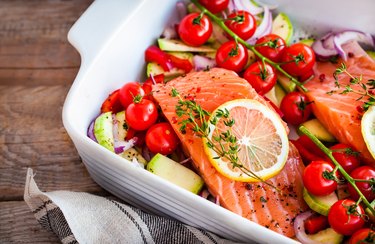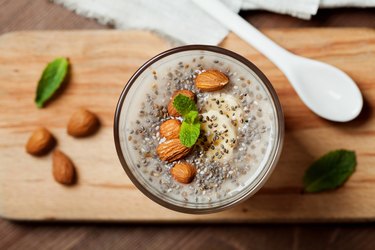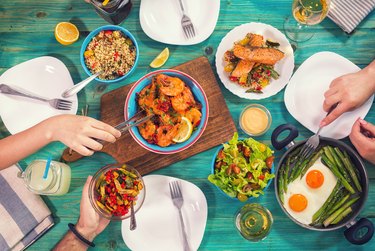
This article is for informational purposes only. The content is in no way sponsored or endorsed by Blue Zones.
If your goal is a long and happy life, then you might have to start looking at what you put on your plate. Longevity, or how many years you live, is increasing thanks to modern medicine and a better understanding of how lifestyle factors can influence health.
It's estimated that anywhere from 20 to 40 percent of your longevity is determined by genetics, according to February 2022 research in the International Journal of Molecular Sciences.
Video of the Day
Video of the Day
That leaves a lot of room for you to potentially increase your years lived simply by altering your lifestyle choices — and looking to the blue zones may be a good place to start.
What's the blue zones diet?
In 2004, with a collaboration between National Geographic and the National Institute on Aging, an author named Dan Buettner set out to find the secret to living longer.
The team found that there were five distinct places in the world that had the largest number of centenarians, or people who lived to be 100. They also found these locations to have lower numbers of chronic diseases, like heart disease, type 2 diabetes and even dementia.
They named these areas the blue zones, and they include:
- Okinawa, Japan
- Sardinia, Italy
- Nicoya, Costa Rica
- Ikaria, Greece
- Loma Linda, California
These five locations were then deemed to be the healthiest places to live, so naturally, they sought to find out why.
Anthropologists, epidemiologists and many researchers traveled to the blue zones to find out what they had in common and they came up with some common themes between all of these places that might contribute to this longevity phenomenon:
- Get natural movement each day
- Have purpose in life
- Find ways to relieve stress
- Stop eating before you're full and eat your largest meal in the middle of the day
- Eat a plant-forward diet
- Limit alcohol intake
- Belong to a faith-based community
- Value family and keep them close
- Maintain healthy social circles
The Diet Basics
It's clear that it takes more than a nutritious diet to reach the age of 100, but the diet in all the blue zones have one commonality: They're largely plant-based.
Eating more veggies doesn't guarantee you'll live longer, but the high amounts of antioxidants, fiber and minimally processed food in plant-based diets are linked to a lower risk of chronic disease.
The blue zones diet focuses on plant foods, with most folks eating meat only five times per month (or about once per week), according to September-October 2016 research in the American Journal of Lifestyle Medicine.
Blue zones diet foods
The blue zones diet can be best described as a flexitarian diet or a Mediterranean diet pattern. It's a largely plant-focused diet, with moderate amounts of dairy, eggs, fish and whole grains.
Foods to Eat a Lot Of
Feel free to eat multiple servings of these foods each day:
- Fruits: Apples, berries, citrus, melons, pomegranates, stone fruit and avocados are just some examples. Eat several whole fruits each day.
- Vegetables: Leafy greens, all squash varieties, fennel, tomatoes, peppers, onions, cucumbers. Make vegetables half of each meal.
- Legumes: Chickpeas, black beans, pinto beans, white beans, kidney beans, all lentil varieties. Eat one cup of legumes daily.
- Olive oil: Replace butter or other oils with olive oil.
- Nuts or nut butters: Almonds, pistachios, peanuts, walnuts. Eat one to two handfuls each day. If choosing a nut butter, avoid those with added sugars.
- Herbs, spices, and vinegars: Use these as your flavorings and seasonings for daily dishes.
- Coffee and tea: These can be enjoyed daily and are a staple in the blue zones diet.
- Water: Make water your main drink of choice to stay hydrated. Drink depending on your activity level, so more if you're active.
Foods to Eat in Moderation
You'll want to eat these foods once a day or a few times a week:
- Grains: Sourdough or whole-grain bread
- Fish: Tuna, salmon, cod, halibut, tilapia
- Whole eggs (don't toss that yolk!)
- Dairy: Greek yogurt, milk, feta cheese, parmesan cheese
- Wine: With the exception of alcohol abstinence for religious reasons, alcohol intake in the blue zones is moderate, with the recommendation of one to two glasses per day.
Foods to Limit
You'll want to limit these foods to once a week or a few times a month:
- Meat: Pork, beef
- Poultry: Chicken, turkey
- Sweets: Sweets like cakes, pies, cookies and pastries are thought of as celebratory foods. Added sugars should be limited to the American Heart Association's recommendation of no more than 6 to 9 teaspoons (24 to 36 grams) per day.
Foods to Avoid
There are no hard-and-fast rules on avoiding foods, but generally, foods that are not eaten regularly in blue zones include:
- Sugar-sweetened beverages: Sodas, sweetened tea, sugary coffee drinks and other drinks with high amounts of added sugar should be avoided whenever possible.
- Ultra-processed foods: Frozen pizzas, chips, crackers and processed meats are not a part of the diet in the blue zones.
How to meal plan for a blue zones-style diet
A hallmark of a blue zones diet is eating minimally processed meals — that means you're cooking from home more. If this is new for you, then gradually ease into this: You can start by cooking at home one more night a week.
If you're already cooking at home, here are some tips to help you plan for eating blue zones-style:
- Because the bulk of the diet is made of plant foods, make sure to fill at least half your plate with vegetables of all kinds. It's also recommended that you eat legumes daily, along with a serving of nuts and multiple servings of fruit.
- Fill in the rest of your plate with whole grains, fish, eggs or dairy for most days of the week.
- Eat fruit daily or simply make it your dessert.
- Stock your pantry with grains (such as quinoa, millet and farro) as well as olive oil, spices and legumes.
- Keep frozen fruit and vegetables in the freezer when you run out of fresh. Add frozen spinach, corn, or peas to soups, stews or pasta dishes.
Your 7-day blue zones-inspired meal plan
Try this weeklong meal plan to kickstart your blue zones diet. You've got three meals a day plus snacks to choose from:
Sunday
- Breakfast: Microgreens are the star of this Breakfast Salad with eggs, from Eating Bird Food blog.
- Lunch: Substitute the egg for edamame in this Kimchi Fried Rice with Sesame Braised Tempeh from the blog Dishing Out Health.
- Dinner: Swap out regular pasta for more veggies in this Instant Pot Spaghetti Squash by Feel Good Foodie blog.
Monday
- Breakfast: Get your healthy fats with this Hummus Avocado Toast with Hemp Seeds from Eating Bird Food.
- Lunch: This Lemon Artichoke Orzo Salad from the blog Dishing Out Health will help you get more vegetables in your day.
- Dinner: Pork Tenderloin with rosemary from the blog Tastes Better From Scratch will be the center of your meal — round it out with roasted carrots and a crisp green salad.
Tuesday
- Breakfast: Baked Oatmeal bars (with fruit) from Little Sunny Kitchen give you 4 grams of fiber per serving.
- Lunch: Tuna and White Bean Salad from the blog Chelsea's Messy Apron comes together in minutes for a quick high-protein lunch.
- Dinner: If you have the time, make a batch of this Vegetarian Chili (from the blog Dinner at the Zoo) to get 15 grams of fiber and 14 grams of protein per serving.
Wednesday
- Breakfast: Baked Egg Muffins (with broccoli, mushrooms and peppers) from Eating Bird Food will get you two servings of vegetables.
- Lunch: This Chana Masala from My Heart Beets blog is loaded with fiber from chickpeas.
- Dinner: This Lentil Pasta with Kale and Marinara Sauce from The Awesome Green blog is the perfect way to get more legumes in your diet.
Thursday
- Breakfast: These Savory Vegan Breakfast Bowls from Nutriciously includes potatoes with high-protein tofu hash to fuel your day.
- Lunch: Add a small Greek salad to this Carrot and Red Lentil Soup (from the blog Real Food Whole Life) to round out your meal.
- Dinner: Get in your omega-3s with Bang Bang Salmon and rice, from The Endless Meal blog.
Friday
- Breakfast: The pick-me-up in this Ginger & Greens Smoothie, from the blog Love and Zest, comes from frozen mango, pineapple and ginger.
- Lunch: Try these quick and tasty Healthy Stuffed Sweet Potatoes with black beans and avocado from the blog Salt & Lavender.
- Dinner: Add two types of beans for more protein and fiber in this Vegan Tortilla Soup from the blog Choosing Chia.
Saturday
- Breakfast: This Protein Oatmeal with Bananas from the blog Feel Good Foodie gives you 23 grams of protein and is a breakfast that feels like dessert.
- Lunch: This Pesto Veggie Pizza from Tastes Better From Scratch is a fun way to get more whole grains in your day.
- Dinner: Slow Cooker Sweet Potato Black Bean Chili from Eating Bird Food provides an impressive 10 grams of plant-based protein.
Snacks
You can choose two to three snacks daily:
- Fresh fruit
- Handful of nuts
- Greek yogurt
- Vegetable sticks with hummus or guacamole
- Roasted chickpeas
- Nut butter and fruit
Things to keep in mind with a blue zones diet
- Don't aim for perfection: You probably won't be able to mimic the exact diet of those who live in blue zones — and that's OK. Don't strive to perfect this diet — you'll still see health benefits by increasing the number of plant foods in your diet.
- Change happens slowly: If you're not currently eating a lot of plant-based meals or cooking at home often, this will be a change for you. Take it slow to keep stress to a minimum and enjoy eating healthier.
- Watch for nutrient deficiencies: When switching to a more plant-based diet, it may be possible to miss out on certain nutrients if you're not careful. Make sure you're getting enough iron (legumes, eggs, meat), calcium (dairy, fortified foods, tofu), vitamin D (fortified foods, salmon, eggs) and vitamin B12 (meat, eggs, dairy). Be especially mindful of the needs of children and older adults. Talk to your doctor or registered dietitian if you have nutrient concerns when switching up your diet.
- International Journal of Molecular Sciences: "Genes and Longevity of Lifespan"
- American Journal of Lifestyle Medicine: "Blue Zones"
- American Heart Association: "Added Sugar"
- Eating Bird Food: "Breakfast Salad"
- Dishing Out Health: "Kimchi Fried Rice with Sesame Braised Tempeh"
- Eating Bird Food: "Hummus Avocado Toast with Hemp Seeds"
- Dishing Out Health: "Easy Lemon Artichoke Orzo Salad"
- Tastes Better From Scratch: "The Best Pork Tenderloin"
- Little Sunny Kitchen: "Easy Baked Oatmeal"
- Chelsea's Messy Apron: "Tuna White Bean Salad"
- Dinner at the Zoo: "Vegetarian Chili"
- Eating Bird Food: "Baked Egg Muffins"
- My Heart Beets: "Chana Masala Instant Pot Recipe"
- The Awesome Green: "Lentil Pasta with Kale and Marinara Sauce"
- Nutriciously: "Savory Vegan Breakfast Bowls"
- Real Food Whole Life: "Easy Carrot and Red Lentil Soup"
- The Endless Meal: "Bang Bang Salmon"
- Love and Zest: "Ginger & Greens Smoothie"
- Salt & Lavender: "Healthy Stuffed Sweet Potatoes"
- Choosing Chia: "Vegan Tortilla Soup"
- Feel Good Foodie: "Protein Oatmeal with Bananas"
- Tastes Better From Scratch: "Easy Pesto Veggie Pizza"
- Eating Bird Food: "Slow Cooker Sweet Potato Black Bean Chili"
- Feel Good Foodie: "Instant Pot Spaghetti Squash"


